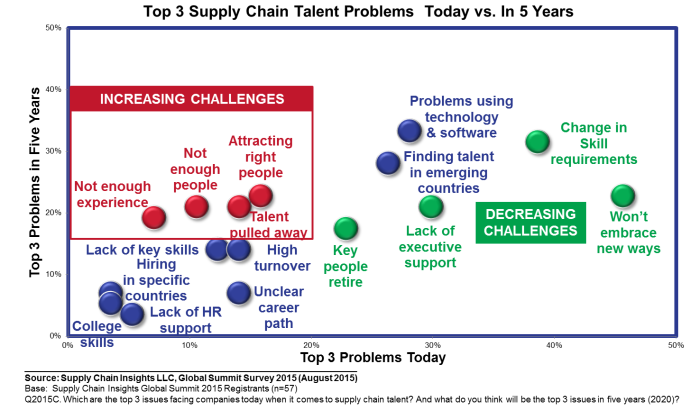 Tomorrow, I am off to Europe. On Thursday I speak on the future of supply chain technologies at an EyeOn conference in Rotterdam. It is the end of the fall conference speaking circuit and I am looking forward to spending time at home over the holidays. While I love talking to supply chain professionals at conferences, and challenging them to think more holistically about supply chain excellence, as the leaves fall I yearn for my home. In my roots I am a homebody. I like winter by a fire.
Tomorrow, I am off to Europe. On Thursday I speak on the future of supply chain technologies at an EyeOn conference in Rotterdam. It is the end of the fall conference speaking circuit and I am looking forward to spending time at home over the holidays. While I love talking to supply chain professionals at conferences, and challenging them to think more holistically about supply chain excellence, as the leaves fall I yearn for my home. In my roots I am a homebody. I like winter by a fire.
Last week I visited a local supply chain team and spoke on Supply Chain 2020. It was open microphone with a group of 30 young professionals. I like talking to young professionals. One of the questions asked was, “What do you believe the impact of social technologies on supply chain will be in 2020.” I smiled and took a deep breath. It is one of my favorite questions. I had a fire in my belly for this answer.
I spoke of Anthony Volpe’s presentation on sentiment analysis at our recent Supply Chain Insights Global Summit. As I spoke, I asked “Who knows what sentiment analysis is?” No one raised their hand. I find very few supply chain professionals understand the promise of mining unstructured text to listen to customer sentiment. In the workshop we talked at length about the use of sentiment analysis to sense quality issues, market opportunities, and new product launch acceptance. I shared how sentiment analysis enables companies to sense product quality issues four to six weeks before knowledge by a traditional call center. It would have helped the GM pinpoint the ignition issue and Kellogg detect the smelly packaging issue faster.
The conversation then spilled over to the use of twitter as a customer service channel. I spoke of my experience during the Icelandic ash issue. Twitter enabled me to get to Europe on one of the few available seats. By listening to the hashtag on the #ashcloud, I got up-to-date information on which planes were flying to Europe. There was no latency. The information allowed me to position myself early in a customer service line in a short window of time when the ash particulate subsided and flights quickly resumed for six hours.
As we brainstormed the opportunities for the people in the room to use social in supply chain processes–linkedin and twitter in their jobs–one of the older managers attending the session interrupted and said, “Remember, the information must be accurate.” I smiled and let the comment go and continued the brainstorming. The older manager interrupted again, and said, “Remember that the information must be accurate.” I smiled and changed the subject.
It is amazing to me that supply chain leaders are willing to accept the data churning out of their spreadsheet ghettos as accurate, but are unwilling to believe/listen to social sentiment because they think the data is inaccurate. I often scratch my head. It does not match my experience. I firmly believe that if a customer cares enough to tweet a concern, complaint, or a recommendation, that the provider of the service is well-served by listening. I find twitter an accurate source of data.
One of the major problems is that most organizations do not know how to listen. Social sentiment and the use of social data as a listening post is a foreign concept. As we continued, the dialogue reminded me of a greater issue. My mind wandered to the chart shown in Figure 1. One of our greatest challenges in managing supply chain talent is embracing new ways of working. I see it everyday. We believe that the data within the organization is accurate and we have best practices that are driven like wildfire throughout divisions and businesses. I, on the other hand, believe that most of the data within our organizations is highly inaccurate with an undesirable level of latency. I also believe that we have evolving practices which can only get better if we throw them on their side and redesign them so that they are outside-in (from the customer back) versus inside-out (from the order in). Inside-out processes focused on enterprise efficiency limit our ability to build value networks and drive waste and cost out of the extended supply chain. However, to seize this opportunity we need to embrace “new ways of working.”
Figure 1. Issues with Supply Chain Talent: Past Five Years Versus Future Five Years

This week, when I am in the Amsterdam airport trying to get home, I will have my mobile phone in my hand. If there is a problem I will not call the Delta support line; instead, I will tweet to get information. The difference in response time is 5-10 minutes. By tweeting I will not be placed on hold, and the information will accurate and timely. I am a road warrior. Road warriors have no patience for long lines, calls placed on hold, or slow answers.
I believe that twitter is a wonderful means to listen to customer sentiment–valuable information on true usage and product acceptance. I also believe that it is an opportunity for many to have a direct line to their customer to help in times of need. What do you think?
About the Author:
 Lora Cecere is the Founder of Supply Chain Insights. She is trying to redefine the industry analyst model to make it friendlier and more useful for supply chain leaders. Lora wrote the books Supply Chain Metrics That Matter and Bricks Matter, and is currently working on her third book, Leadership Matters. As a frequent contributor of supply chain content to the industry, Lora writes by-line monthly columns for SCM Quarterly, Consumer Goods Technology, Supply Chain Movement and Supply Chain Brain. She also actively blogs on her Supply Chain Insights website, for Linkedin, and for Forbes. When not writing or running her company, Lora is training for a triathlon, taking classes for her DBA degree in research at Temple or knitting and quilting for her new granddaughter. In between writing and training, Lora is actively doing tendu (s) and Dégagé (s) to dome her feet for pointe work at the ballet barre. She thinks that we are never too old to learn or to push an organization harder to improve performance.
Lora Cecere is the Founder of Supply Chain Insights. She is trying to redefine the industry analyst model to make it friendlier and more useful for supply chain leaders. Lora wrote the books Supply Chain Metrics That Matter and Bricks Matter, and is currently working on her third book, Leadership Matters. As a frequent contributor of supply chain content to the industry, Lora writes by-line monthly columns for SCM Quarterly, Consumer Goods Technology, Supply Chain Movement and Supply Chain Brain. She also actively blogs on her Supply Chain Insights website, for Linkedin, and for Forbes. When not writing or running her company, Lora is training for a triathlon, taking classes for her DBA degree in research at Temple or knitting and quilting for her new granddaughter. In between writing and training, Lora is actively doing tendu (s) and Dégagé (s) to dome her feet for pointe work at the ballet barre. She thinks that we are never too old to learn or to push an organization harder to improve performance.

The Tale of the Gartner Supply Chain Planning Magic Quadrant and Minestrone Soup
Self-congratulations notes abounded this week as vendor-after-vendor shared their rankings on the Gartner Magic Quadrant for Supply Chain Planning. For me, it was a big






